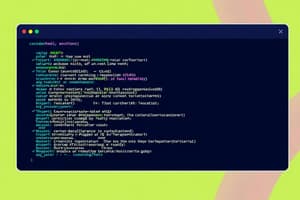Podcast
Questions and Answers
What is the purpose of HTML?
What is the purpose of HTML?
- To add interactivity to web pages
- To control the layout and appearance of web pages
- To create databases for web applications
- To create web pages (correct)
What is the function of the `` tag in HTML?
What is the function of the `` tag in HTML?
- Specifies the root element of the document
- Contains the content of the HTML document
- Contains metadata about the document (correct)
- Declares the document type
Which HTML tag is used to create headings?
Which HTML tag is used to create headings?
- img
- p
- h1 (correct)
- a
What is the purpose of CSS?
What is the purpose of CSS?
What is the structure of a CSS rule?
What is the structure of a CSS rule?
What type of CSS selector targets elements with a specific class?
What type of CSS selector targets elements with a specific class?
What is the purpose of the display CSS property?
What is the purpose of the display CSS property?
Which CSS property is used to set the width of an element?
Which CSS property is used to set the width of an element?
What is the primary function of the HTTP protocol in the web architecture?
What is the primary function of the HTTP protocol in the web architecture?
What is the main difference between front-end and back-end development?
What is the main difference between front-end and back-end development?
What is the term for the process of interpreting and displaying HTML, CSS, and JavaScript code in a web page?
What is the term for the process of interpreting and displaying HTML, CSS, and JavaScript code in a web page?
What is the relationship between the internet and the web?
What is the relationship between the internet and the web?
What is the purpose of the client-server architecture in the web?
What is the purpose of the client-server architecture in the web?
What is the term for the individual components of a web page, such as headings, paragraphs, and images?
What is the term for the individual components of a web page, such as headings, paragraphs, and images?
What is the cycle where a client sends a request to a server, and the server responds with the requested data?
What is the cycle where a client sends a request to a server, and the server responds with the requested data?
What is the term for the meaning of an element, such as a heading or paragraph, which is conveyed by its tag?
What is the term for the meaning of an element, such as a heading or paragraph, which is conveyed by its tag?
Flashcards are hidden until you start studying
Study Notes
HTML (Hypertext Markup Language)
- A standard markup language used to create web pages
- Consists of a series of elements represented by tags (<>)
- Tags usually come in pairs, with the opening tag preceding the content and the closing tag following the content
Basic HTML Structure
- ``: declaration of document type
- ``: root element of the document
- ``: contains metadata about the document
- ``: contains the content of the HTML document
HTML Elements
- Headings:
h1,h2,h3, etc. for headings - Paragraphs:
pfor paragraphs of text - Links:
afor hyperlinks - Images:
imgfor adding images - Lists:
ul,ol, andlifor unordered, ordered, and list items respectively - Tables:
table,tr, andtdfor tables, table rows, and table data respectively
CSS (Cascading Style Sheets)
- A styling language used to control the layout and appearance of web pages
- Consists of rules, known as styles, that are applied to HTML elements
CSS Syntax
- A CSS rule consists of a selector, a property, and a value
- Example:
p { color: blue; }sets the text color of paragraphs to blue
CSS Selectors
- Element Selectors:
p,h1,img, etc. select HTML elements - Class Selectors:
.classnameselects elements with a specific class - ID Selectors:
#idnameselects an element with a specific ID
CSS Properties
- Color and Background:
color,background-color,background-image, etc. - Text:
font-family,font-size,text-align, etc. - Box Model:
width,height,margin,padding, etc. - Layout:
display,float,position, etc.
HTML (Hypertext Markup Language)
- A standard markup language used to create web pages, consisting of a series of elements represented by tags.
- Tags usually come in pairs, with the opening tag preceding the content and the closing tag following the content.
Basic HTML Structure
- The document type is declared using ``.
- The root element of the document is represented by ``.
- The `` element contains metadata about the document.
- The `` element contains the content of the HTML document.
HTML Elements
- Headings are represented by
h1,h2,h3, etc. - Paragraphs of text are represented by
p. - Hyperlinks are represented by
a. - Images are added using
img. - Unordered lists, ordered lists, and list items are represented by
ul,ol, andlirespectively. - Tables are created using
table,tr, andtdfor tables, table rows, and table data respectively.
CSS (Cascading Style Sheets)
- A styling language used to control the layout and appearance of web pages, consisting of rules known as styles that are applied to HTML elements.
CSS Syntax
- A CSS rule consists of a selector, a property, and a value.
- Example:
p { color: blue; }sets the text color of paragraphs to blue.
CSS Selectors
- Element selectors such as
p,h1,img, etc. select HTML elements. - Class selectors such as
.classnameselect elements with a specific class. - ID selectors such as
#idnameselect an element with a specific ID.
CSS Properties
- Color and background properties include
color,background-color,background-image, etc. - Text properties include
font-family,font-size,text-align, etc. - Box model properties include
width,height,margin,padding, etc. - Layout properties include
display,float,position, etc.
Web Fundamentals
- The web is a system of interlinked hypertext documents, accessible via the Internet.
Key Components
- HTML (Hypertext Markup Language) is a markup language used to create web pages.
- CSS (Cascading Style Sheets) is a styling language used to control the layout and appearance of web pages.
- JavaScript is a programming language used to add interactivity to web pages.
- HTTP (Hypertext Transfer Protocol) is a protocol used for transferring data over the web.
Web Architecture
- The client-server architecture is a model where clients (web browsers) request resources from servers, which respond with the requested data.
- The request-response cycle is a cycle where a client sends a request to a server, and the server responds with the requested data.
Web Page Structure
- Elements are individual components of a web page, such as headings, paragraphs, images, and links.
- Tags are HTML codes used to define elements.
- Semantic meaning is the meaning of an element, such as a heading or paragraph, which is conveyed by its tag.
Web Development
- Front-end development is the development of the client-side of a web application, using HTML, CSS, and JavaScript.
- Back-end development is the development of the server-side of a web application, using programming languages such as Python, Ruby, or PHP.
- Full-stack development is the development of both the front-end and back-end of a web application.
Web Browsers
- Popular web browsers include Google Chrome, Mozilla Firefox, Microsoft Edge, Safari, and Opera.
- Browser rendering is the process of interpreting and displaying HTML, CSS, and JavaScript code in a web page.
Internet and Web
- The internet is a global network of interconnected computers and servers.
- The web is a system of interlinked hypertext documents, accessible via the internet.
Studying That Suits You
Use AI to generate personalized quizzes and flashcards to suit your learning preferences.




